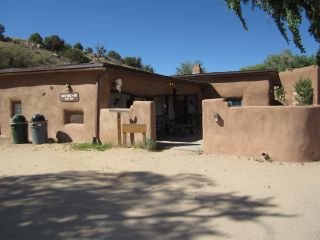Law and Crime
Nineteenth-century Serial Killers at Ghost Ranch
Georgia O’Keeffe’s favorite place has a violent past.
Posted June 5, 2013

Recently, I went on a psychological pilgrimage to an educational retreat center known as Ghost Ranch. It was here that the reclusive American artist Georgia O’Keeffe had led a solitary life. She’d purchased one of the adobe homes on this 22,000-acre ranch in northern New Mexico because she'd fallen in love with the barren landscape.
I understand the appeal. The land demands that you rise to the occasion or leave. It's not for everyone. But just by gazing at the cliffs and buttes, you can learn a lot about the psychology of her art.
I went to see where she’d called home, and in the process I discovered some interesting history. This place wasn't always called Ghost Ranch. I heard several accounts and they all come back to a pair of cattle rustling serial killers. Thanks to their wicked deeds, Ghost Ranch had originally been dubbed el Rancho de Los Brujos, or the Ranch of the Witches.
According to a book by Lesley Polling-Kempes, Ghost Ranch, this property 15 miles north of the town of Abiquiu offered the Rito del Yeso spring, one of the few dependable water sources in an otherwise arid zone. During the late 1800s, the Archuleta brothers claimed the expansive tract for their cattle. One had a wife, so they built primitive cedar-and-adobe structures for their respective homes.
Other cattlemen coming through sought shelter and hospitality. Usually, they disappeared while their horses and goods showed up in the brothers’ possession and their herds were sold. With little law enforcement around and most people scared of "Los Animales," the brothers got away with murder and thieving for years.
If history is to be believed, they became quite prolific as serial killers of the American West, although they show up on few – if any – criminology lists.
Tales arose about bodies thrown into wells and people pushed to their deaths off the high cliffs onto the hard ground below. Ghost stories soon followed. Some people claimed to hear the wailing voices of murder victims, while others said that the brothers themselves started rumors of ghosts to keep strangers away. Apparently, they strung up dummies in the trees and fabricated stories about monsters.
Years later, the married brother's daughter described "earth babies," or six-foot humanlike beasts covered in red hair that arose from the reddish sand and howled like abandoned infants. Her father had also described a witch in the form of a winged cow that claimed the lives of any who saw her fly by. Then there was a 30-foot-long serpent, Vivaron, which supposedly emerged at sunset.
Most such violent partnerships generally end badly, a fact we know from the serial killer teams we study today. Thus, it's no surprise that these guarded, paranoid men would eventually grow suspicious of each other.
After selling a stolen herd, brother #1 told brother #2 that he'd buried the gold he'd received in a clay jar in a secret spot on the property. Brother #2 demanded to know where it was. They got into a fight and #2 killed #1. The trouble was, now #2 really wouldn’t find the gold!
He believed that #1's wife must know where it was, so he threatened her and her daughter. He left them alone overnight to think about it and they apparently decided that Vivaron and the earth babies were less daunting than the surviving member of Los Animales. They packed up and fled.
Since brother #2 was now alone and vulnerable, a group of men formed a posse, rode to the ranch, and hanged him from a cottonwood tree. The ranch buildings were boarded up and no one stuck around to look for the remains of the many missing people (or for the gold).
In 1918, a descendant filed for a homestead patent, but sold the place two years later. It went through several hands before Roy Pfaffle won the deed in a card game.
Pfaffle gave it to his wife, Carol Bishop Stanley, who registered it in her name in 1929. When they later divorced, she moved into the lone deteriorating home still standing and recreated the place as a riding resort. Eventually, it became Ghost Ranch.
So, for over a century, this dramatic New Mexican landscape has had many spiritual associations, both dark and light. Today, it's mostly aimed at refreshing the soul – just as O'Keeffe would want it.




